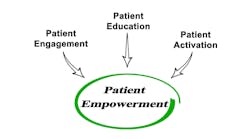Improving patient and physician experience with integrated online self-scheduling
Vice President,
Products
Management,
R1 RCM
Scheduling an imaging test may seem like a small task, but it is enormously important to the patient experience and to a healthcare organization’s revenue in several ways.
In fact, 70% to 75% of patients referred to a hospital receive some form of imaging, while hospital-based imaging contributes 35% to 37% to overall profit margin.1 In many cases, imaging confirms the need for surgery, which accounts for 48% of hospital revenue, and without it the proper diagnosis may be delayed or not occur at all.2 If a physician’s office has difficulty scheduling a CT, MRI, ultrasound, or other such diagnostic test with one health system, the patient may not receive timely care they need, which further reduces satisfaction and may lead to poorer outcomes.
Helping patients secure the test they need, at a convenient time and location, is crucial to delivering a positive care experience. Maintaining patient satisfaction through efficient and simplified scheduling can also impact a health system’s market share. During stressful and likely time-sensitive situations, patients and their physicians expect ease of access to hospital-based services. Doctors put a high importance on accessibility in the scheduling process when choosing where to send their patients.
Streamlining the scheduling experience
Ensuring that patients receive the care they need within a given healthcare network is heavily dependent on the scheduling process. Scheduling needs to facilitate access to convenient times and locations, while also guaranteeing that the correct resources are booked based on a specific patient condition or medical need. Most of all, the process needs to be easy for patients and their referring physicians to navigate. This was a challenge faced by one of the largest, national nonprofit hospital organizations in one of its southern United States’ territories.
Call center staffing challenges frustrate physician offices
The territory’s busy call center employed 25 representatives who scheduled imaging, labs, and nonsurgical procedures for seven hospitals. The call center, however, struggled with high representative turnover and work-shift conflicts. A lack of consistent staffing levels meant that occasionally the practices scheduling appointments would wait on hold for long periods of time, frustrating both staff and patients. Calls would even go unanswered due to volume and lack of available representatives.
This territory is also in a highly competitive market facing off against two other major, integrated delivery networks.
Online self-service scheduling portal rapidly adopted
Recognizing the challenge, the organization worked with its revenue cycle management partner to introduce an online, integrated, and intuitive self-service appointment scheduling portal to these offices. The scheduling tool is just one part of a comprehensive, multifunctional patient and physician self-service revenue cycle management platform, which is gradually being implemented.
Training sessions were offered, but many of the front-office staff eagerly began scheduling on the tool before training began.
Now, instead of scheduling appointments in only the call center, front office staff in 15 physician offices can log-in to the self-service portal and view available times and locations for all diagnostic imaging including CT, MRI, ultrasounds, as well as lab and nonsurgical procedures. Cloud-based and accessible through a web browser, the portal is easily scalable as more offices are added. Furthermore, as the solution is more broadly implemented, it will begin to seamlessly integrate other processes that have traditionally required extra burdensome work on the part of patients and physicians, including the following:
- Demographic accuracy
- Eligibility validation and insurance plan attribution
- Authorization and referral requirements
- Medical necessity validation
- Patient out-of-pocket cost estimation
Pilot exceeds expectations in adoption, performance, and satisfaction
The imaging, lab, and nonsurgical procedure appointment scheduling portal pilot project surpassed expectations, with some impressive results in just six months after implementation, such as:
- 40% utilization rate, far exceeding the 10% goal
- Average call-to-answer time at the call centers decreased from more than a 1 minute to less than 20 seconds—a 67% reduction
- Nearly unanimous positive feedback and reception by end-users
The physician practices also noticed an uptick in productivity, since front staff can serve more patients in the office or on the phone and spend less time waiting for a call center representative. Offering patients a prompt imaging, lab, or nonsurgical procedure appointment time while still in the physician office has helped retain patients in the organization’s network while ensuring they remain satisfied with the service.
The organization continues to evaluate performance metrics post roll-out, but it expects to soon offer the self-scheduling functionality to patients for physician office visits, X-rays, simple CT scans, therapies as well as education and clinic visits.
As the organization confirmed during this pilot, scheduling imaging, labs, and other nonsurgical procedures is crucial to ensure a positive patient experience as well as strong continuity of care. By adopting an online, integrated, and intuitive self-service scheduling tool, the organization delivered superior service by instantly offering appointments at convenient times and locations, reducing patient stress and uncertainty. By doing so, the organization also kept the patient within their network while improving operational efficiency and productivity. As the industry continues to evolve toward more self-service, tools such as these that are integrated, accessible, and easy to use have become mandatory for scheduling, as well as other revenue cycle processes, to ensure a positive experience for patients and physicians.
References:
- Halim, Lea. “5 things CEOS need to know about imaging services.” Advisory Board. September 2, 2016. Accessed May 9, 2018.
- Weiss, Audrey J. et al. “Characteristics of Operating Room Procedures in U.S. Hospitals, 2011.” Healthcare Cost and Utilization Project, AHRQ. Statistical Brief #170. February 2014. Accessed May 9, 2018.



